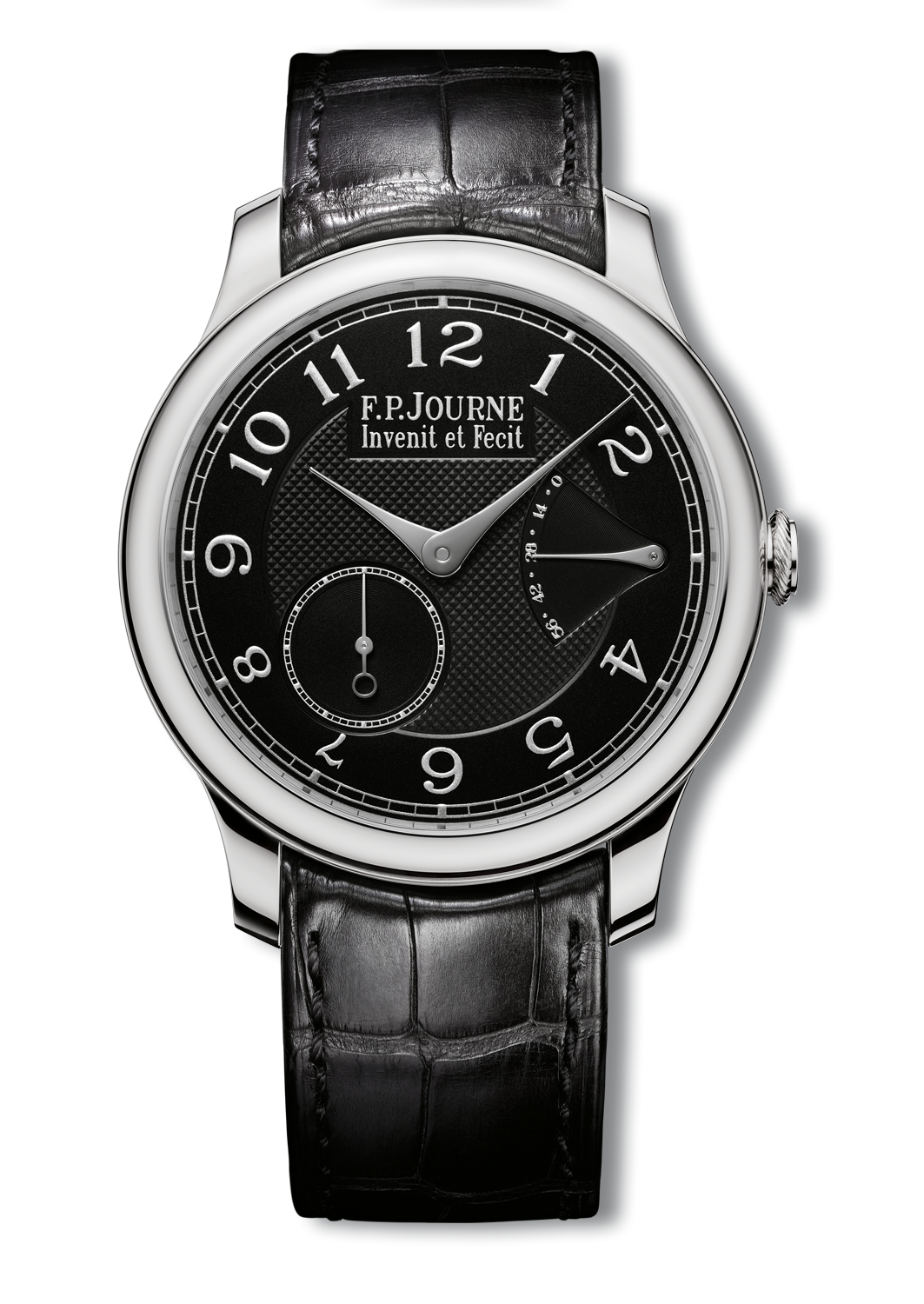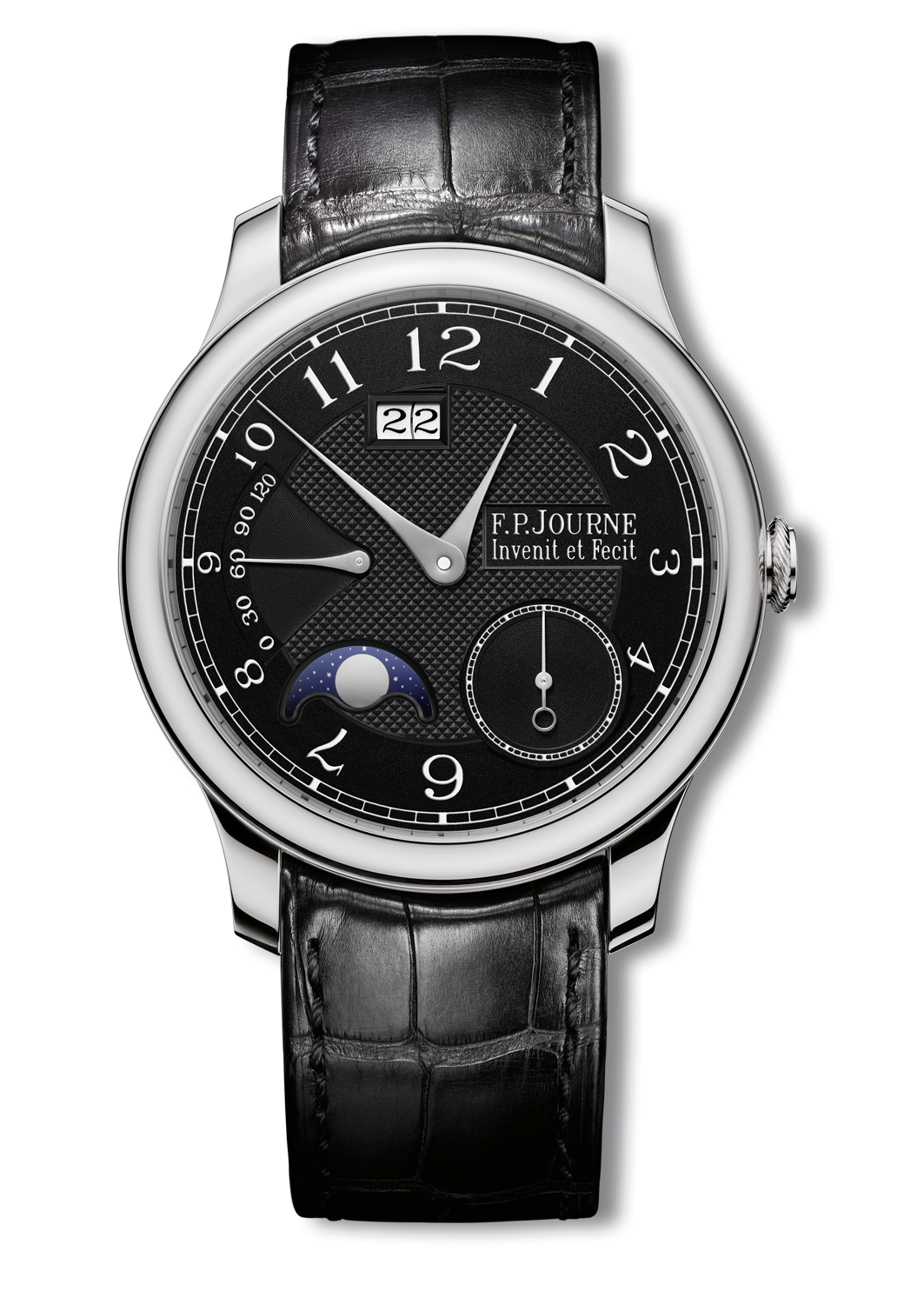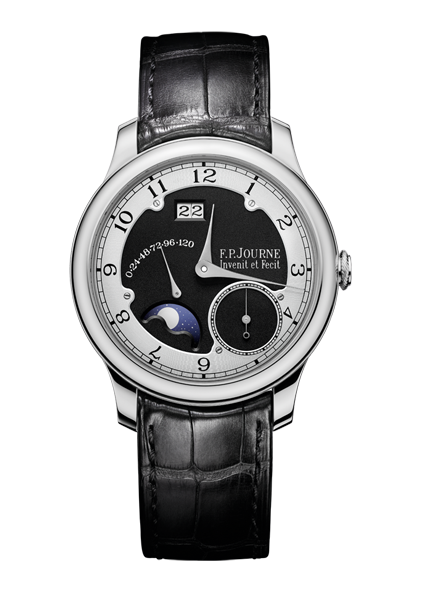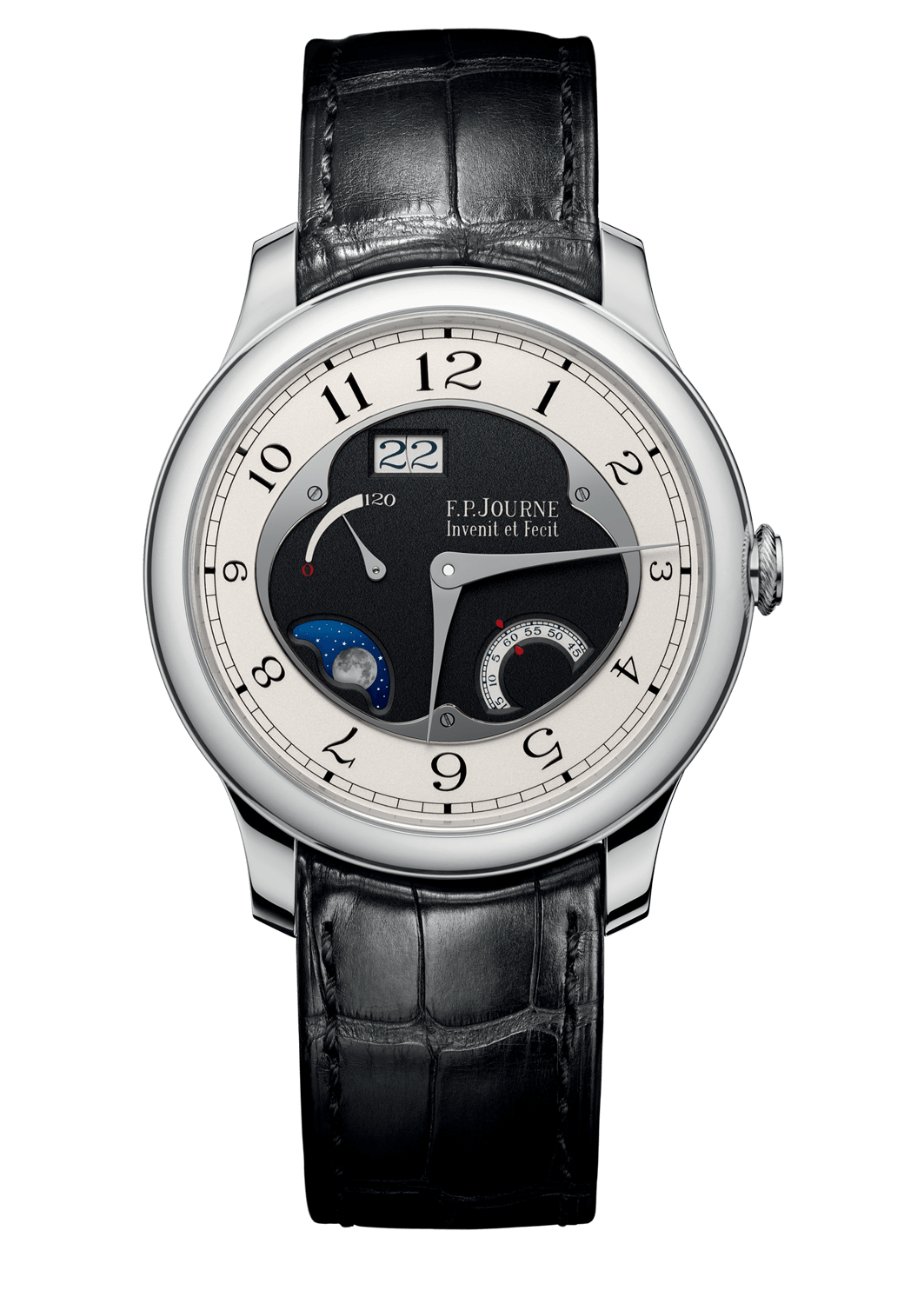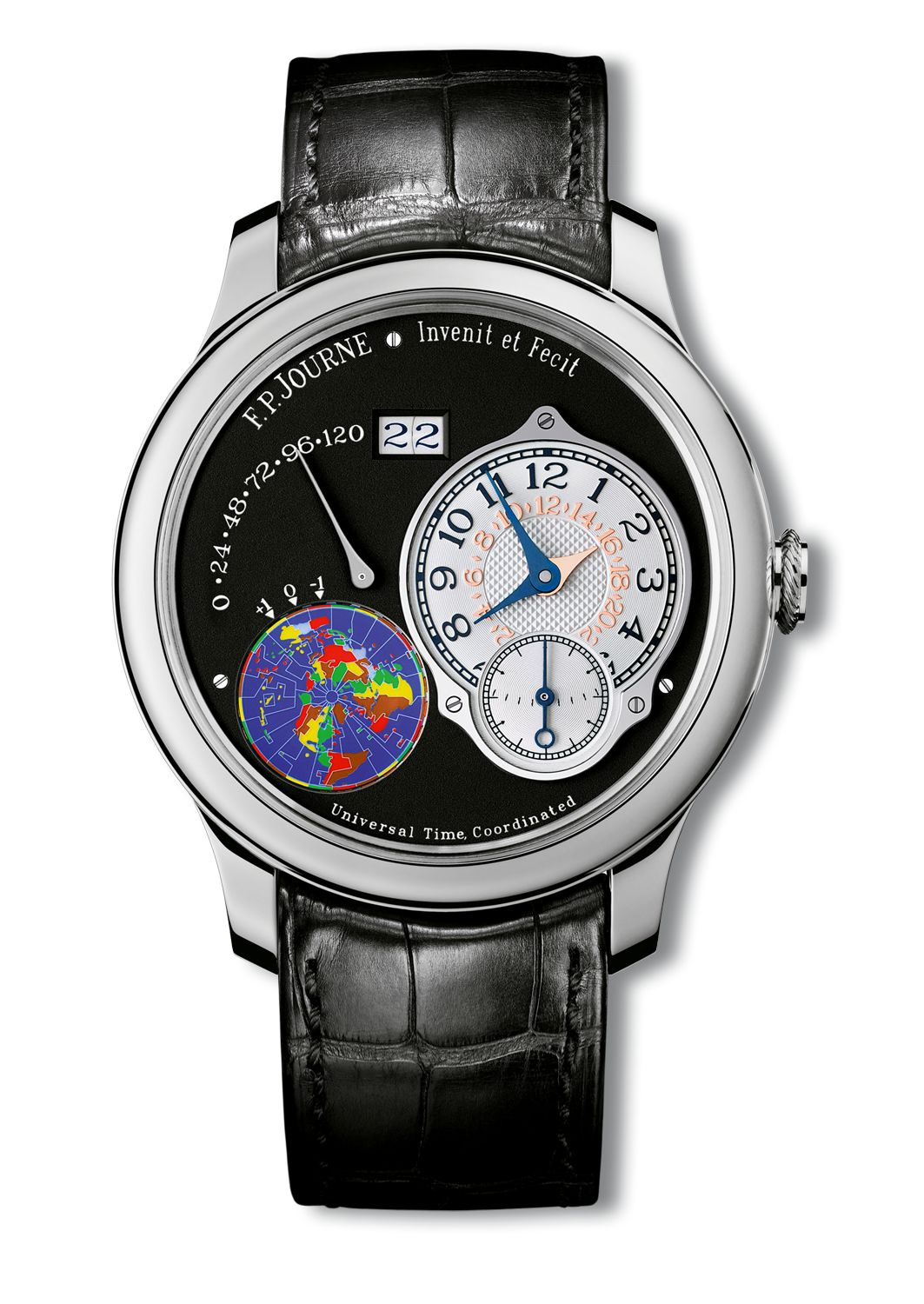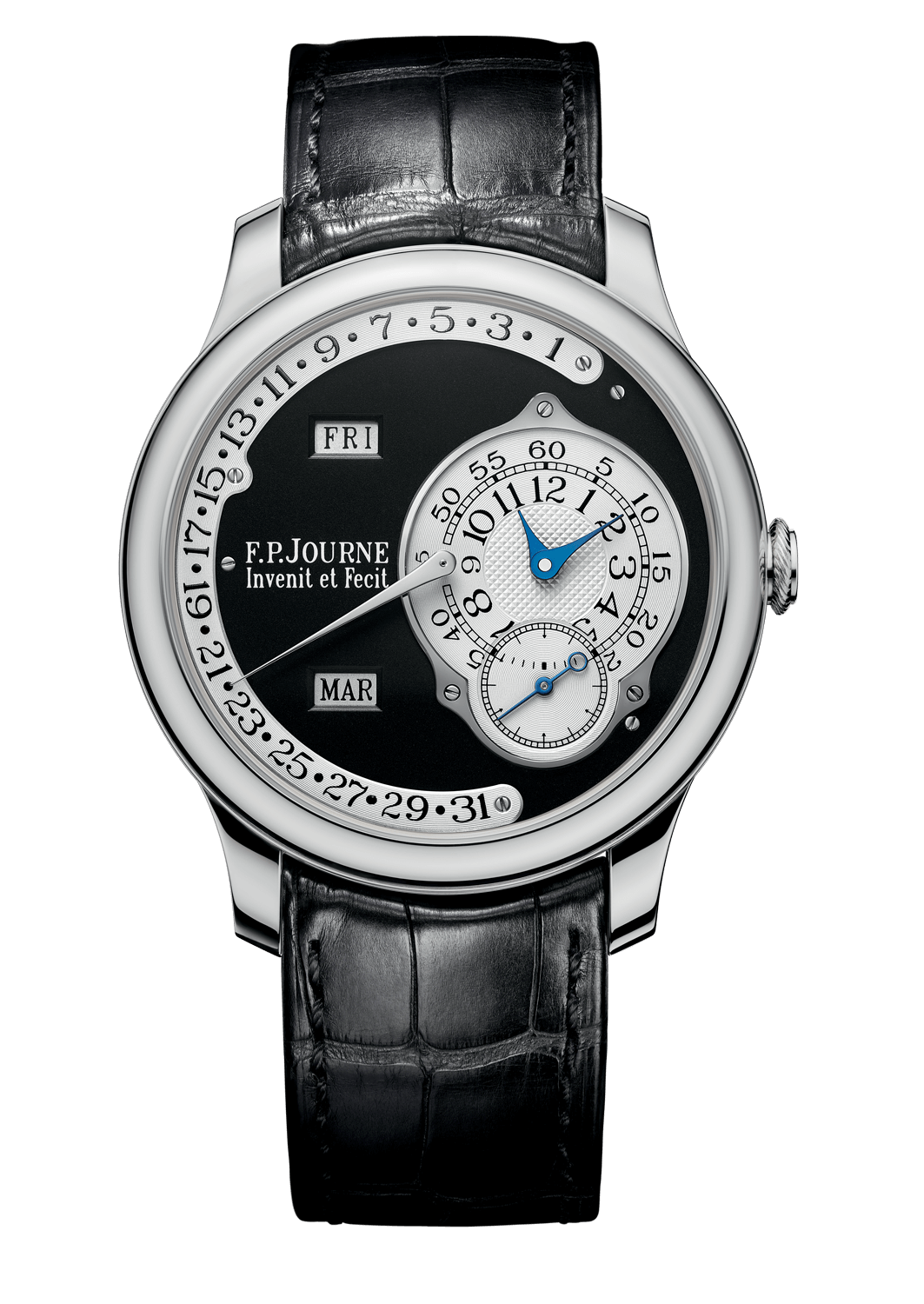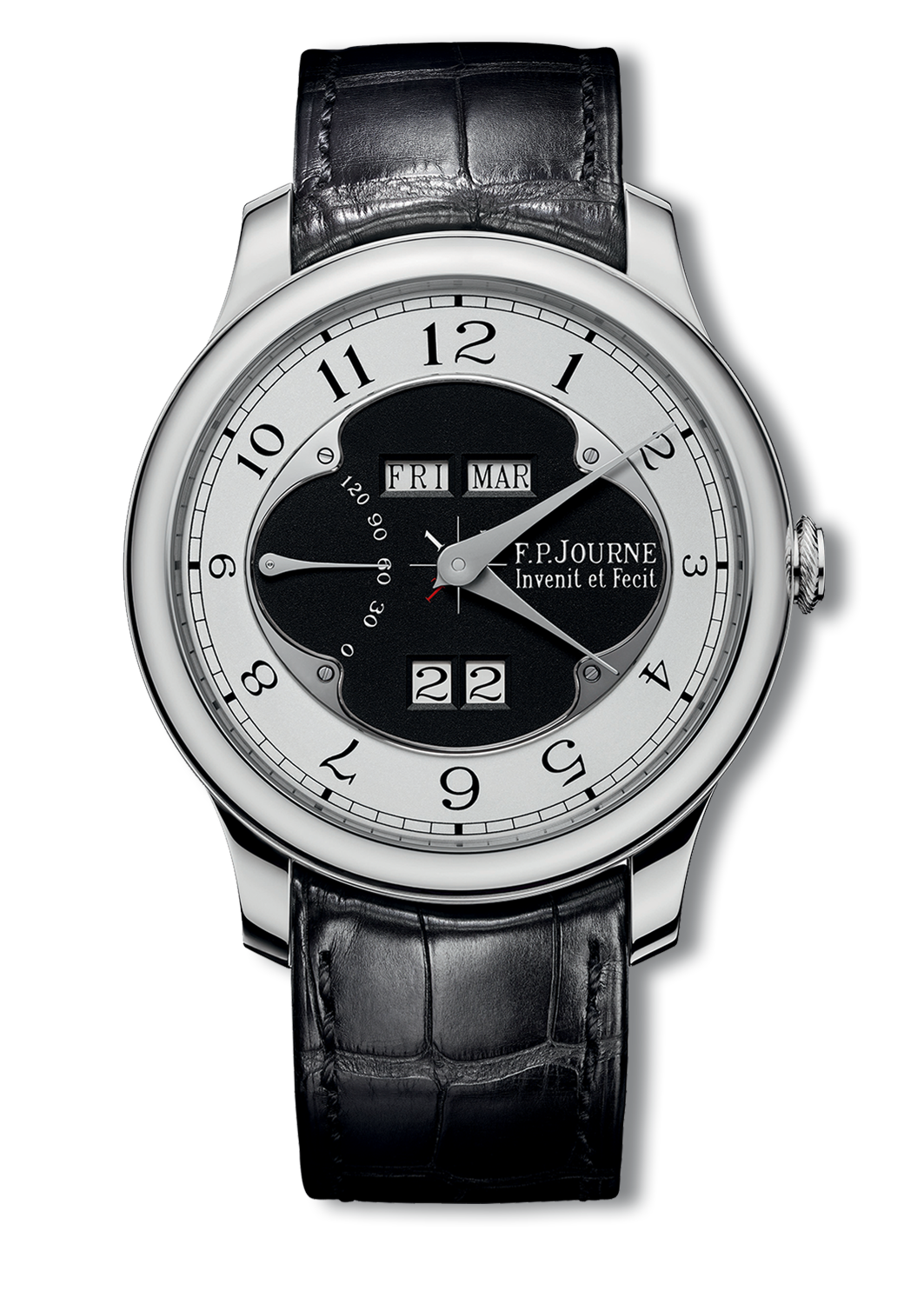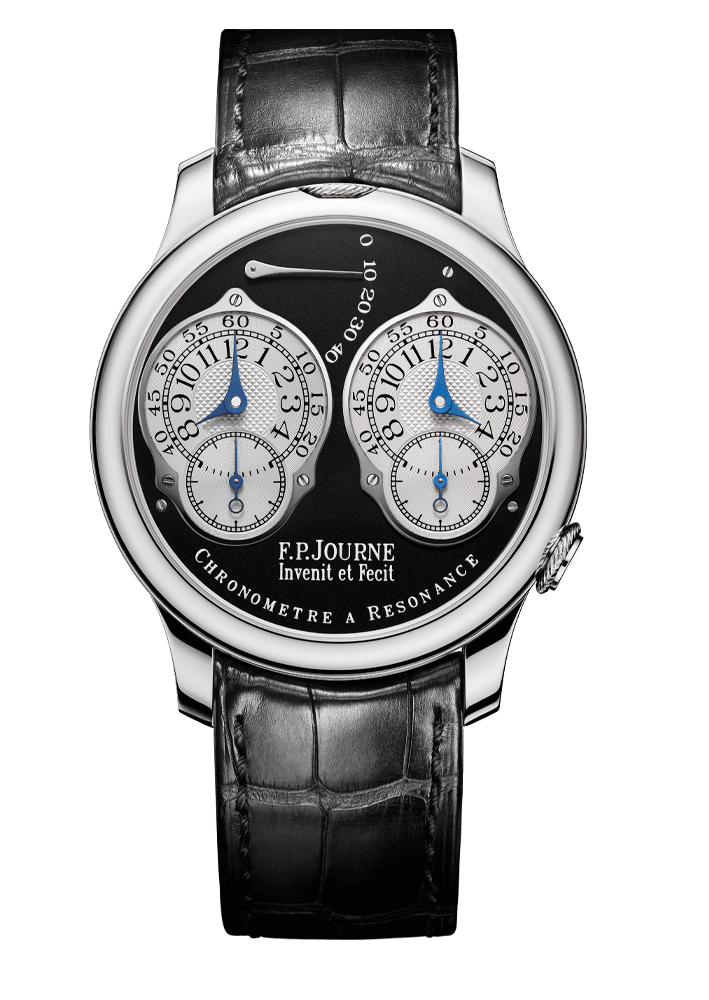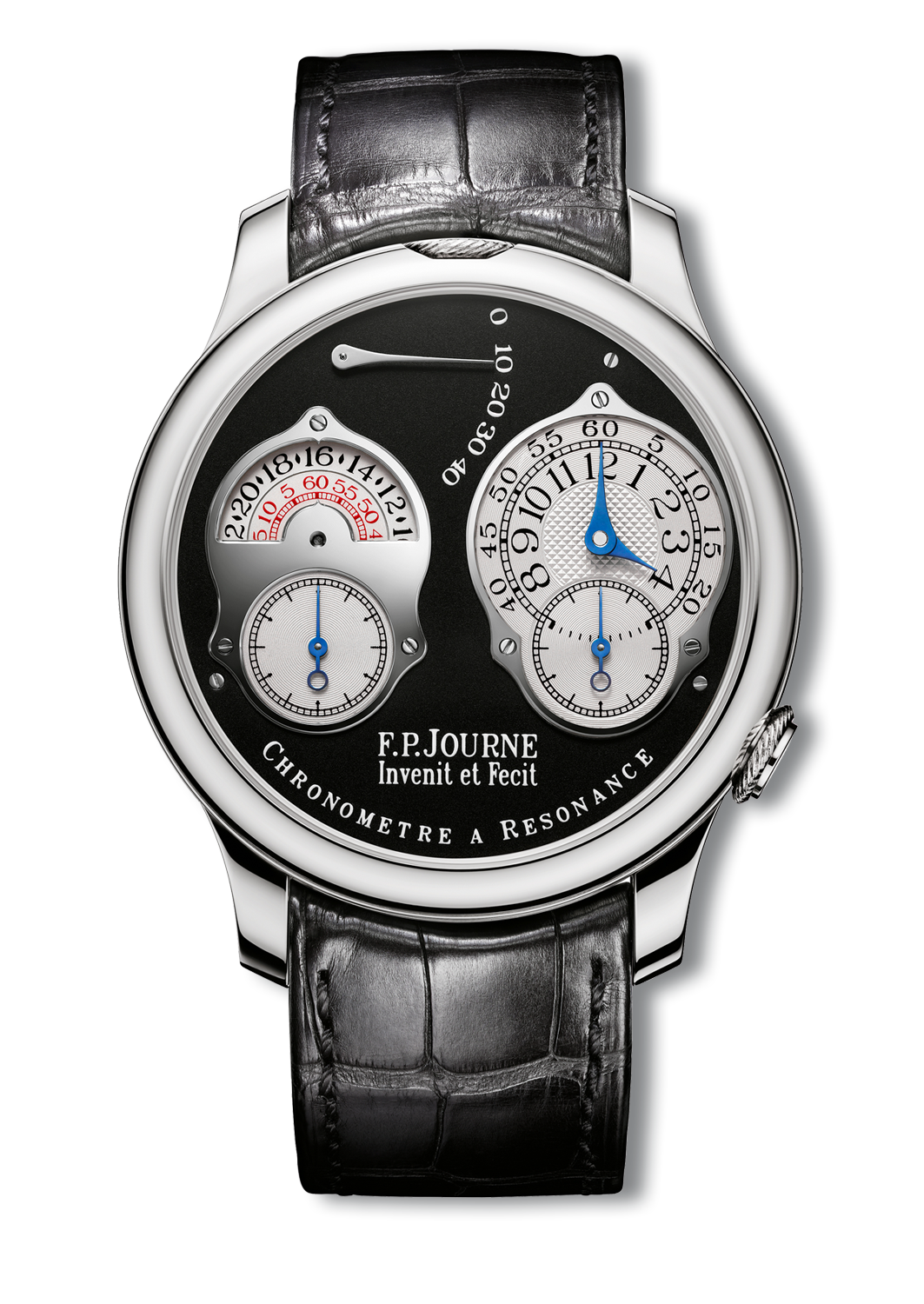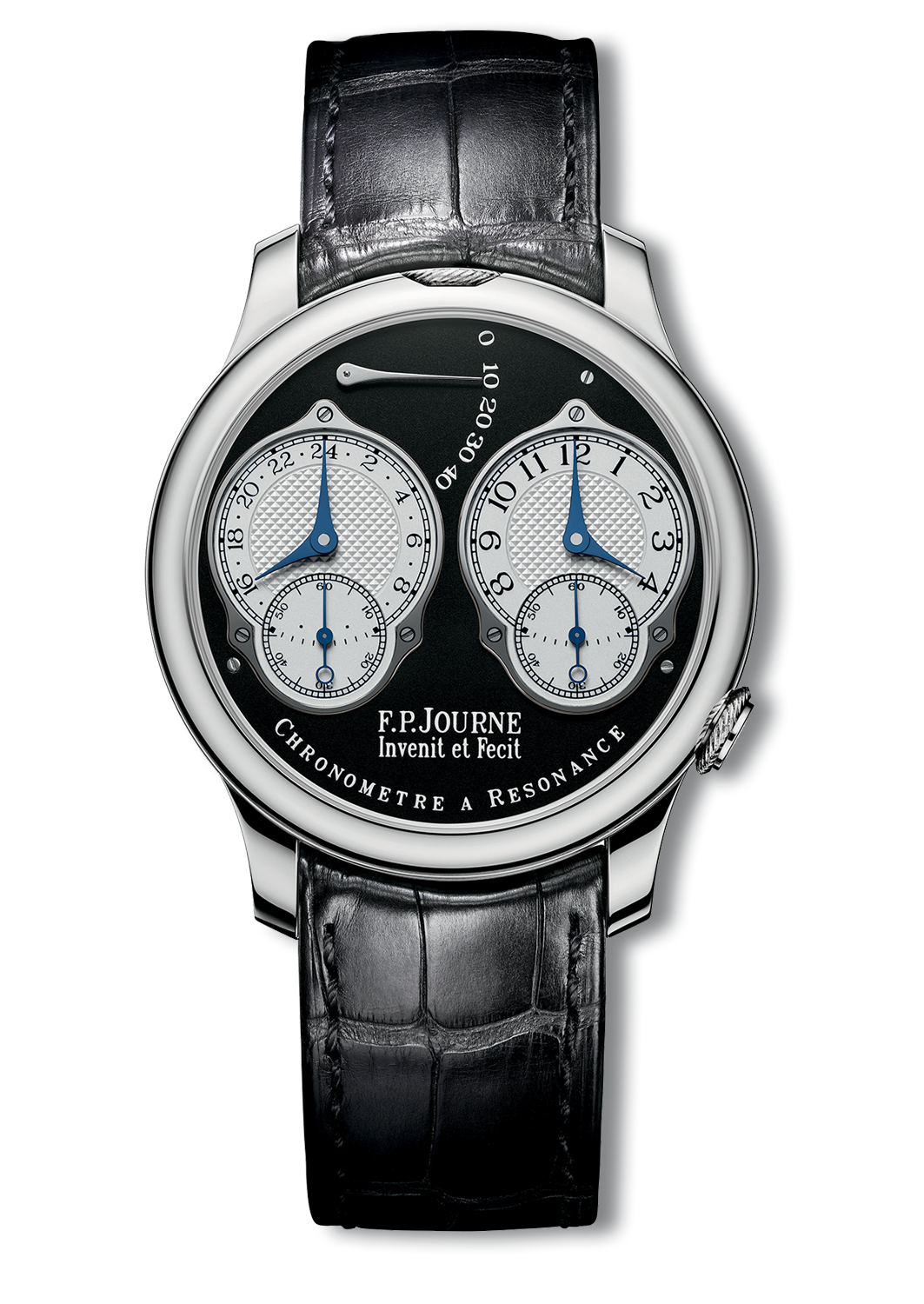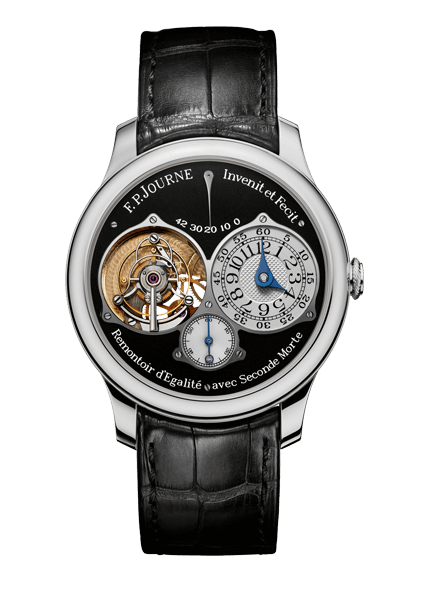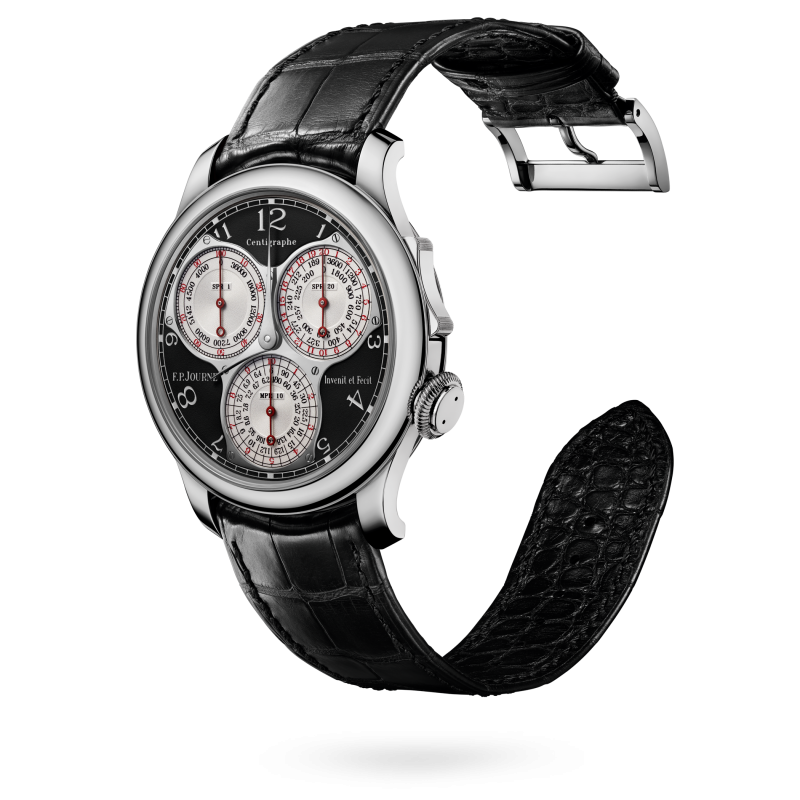Calibre 1506 https://www.fpjourne.com/en/collection/black-label-collection/black-label-collection-centigraphe-souverain FP Journe https://www.fpjourne.com/en FP Journe
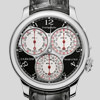
Diameter: 40 mm
Overall height: 10.1 mm
Dial: blackened Gold and whitened guilloché Silver
Hands: rhodium plated and red lacquered Steel
Technical Specifications
- Winding : Manual
- Movement in 18K rose gold : 50 jewels
- Overall diameter : 34.40 mm
- Casing-up diameter : 34.00 mm
- Overall height : 5.60 mm
- Height of hands : 1.45 mm
- Height of winding system : 2.69 mm
- Diameter of stem thread : S1.20 mm
Free-sprung balance
Four adjustable inertia weights
Anachron balance spring
Mobile stud holders
Pinned GE stud
Spring pinned to the collect
21,600 v/h, (3Hz)
10.10 mg / cm2
52°
0h dial up: 320°
24h dial up: 280°
In-line lever escapement
15-tooth escape wheel
Central hours and minutes
One-second chronograph hand at 10 o'clock.
20-seconds chronograph hand at 2 o'clock.
10-minutes chronograph hand at 6 o'clock.
Separate chronograph train driven by directly from the mainspring.
1/100th second readout
80 ± 2 hours with the chronograph stopped
24 ± 2 hours with the chronograph running
Circular stripes on the bridges
Circular graining on the baseplate
Polished screw heads with chamfered slots
Pegs with polished rounded ends
Straight-grained steel work
Rocker arm to start, stop and zero the chronograph
Three-position winding crown:
Position 0: disengaged
Position 1: winding
Position 2: time-setting
Movement without dial: 284
Cased up with strap: 324
- Winding : Manual
- Movement in 18K rose gold : 50 jewels
- Overall diameter : 34.40 mm
- Casing-up diameter : 34.00 mm
- Overall height : 5.60 mm
- Height of hands : 1.45 mm
- Height of winding system : 2.69 mm
- Diameter of stem thread : S1.20 mm
Free-sprung balance
Four adjustable inertia weights
Anachron balance spring
Mobile stud holders
Pinned GE stud
Spring pinned to the collect
21,600 v/h, (3Hz)
10.10 mg / cm2
52°
0h dial up: 320°
24h dial up: 280°
In-line lever escapement
15-tooth escape wheel
Central hours and minutes
One-second chronograph hand at 10 o'clock.
20-seconds chronograph hand at 2 o'clock.
10-minutes chronograph hand at 6 o'clock.
Separate chronograph train driven by directly from the mainspring.
1/100th second readout
80 ± 2 hours with the chronograph stopped
24 ± 2 hours with the chronograph running
Circular stripes on the bridges
Circular graining on the baseplate
Polished screw heads with chamfered slots
Pegs with polished rounded ends
Straight-grained steel work
Rocker arm to start, stop and zero the chronograph
Three-position winding crown:
Position 0: disengaged
Position 1: winding
Position 2: time-setting
Movement without dial: 284
Cased up with strap: 324
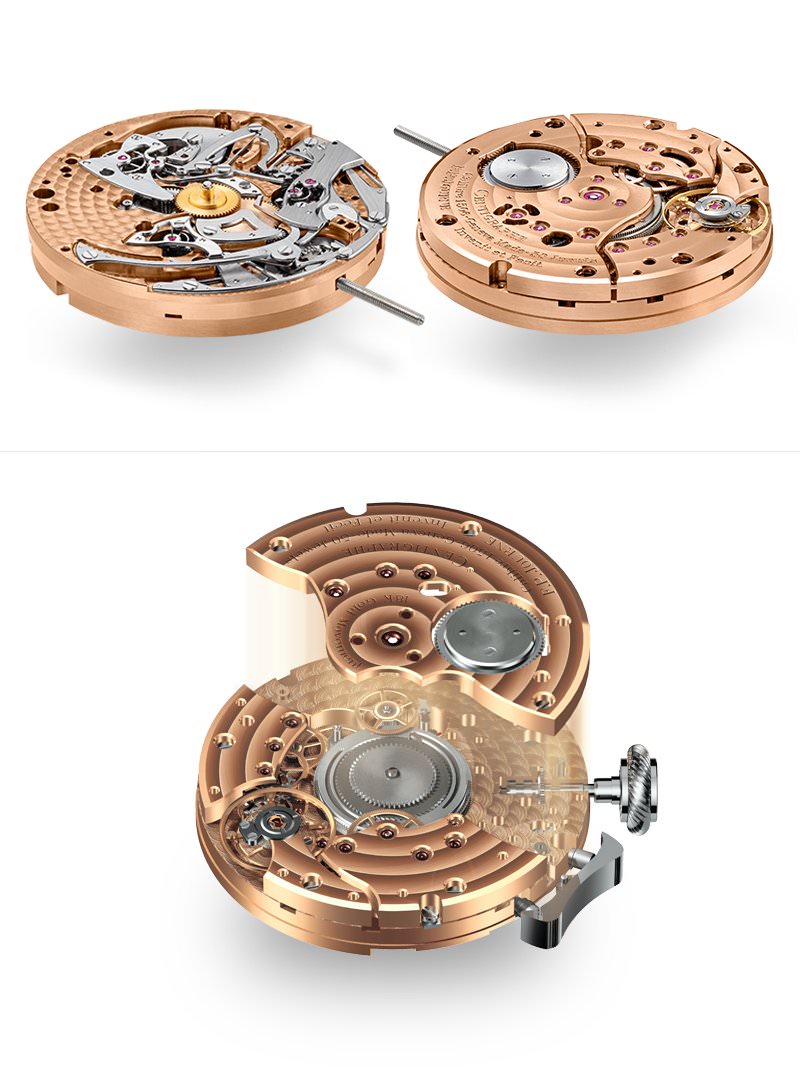
Technical description
For this movement unlike any other, F.P. Journe has set up an ergonomic chronograph activation system with a rocker arm that allows the chronograph to start, stop and zero at 2 o’clock in the case band, instead of the usual buttons on either side of the crown. The chronograph function has also been isolated from the timekeeping function, meaning that the balance amplitude is unaffected when the chronograph is running.
These two innovations have been patented.
The hand-wound mechanical movement of the Centigraphe indicates elapsed times from a 100th of a second to 10 minutes, visible on 3 dials, each with a time scale in red and a tachometer scale in black.
The tachometer scales converts time units for 1 kilometer into speeds ranging from 6 km/h —walking pace — to 36'000 km/h, well above the escape velocity of a rocket going into low-level orbit.

Technical description
For this movement unlike any other, F.P. Journe has set up an ergonomic chronograph activation system with a rocker arm that allows the chronograph to start, stop and zero at 2 o’clock in the case band, instead of the usual buttons on either side of the crown. The chronograph function has also been isolated from the timekeeping function, meaning that the balance amplitude is unaffected when the chronograph is running.
These two innovations have been patented.
The hand-wound mechanical movement of the Centigraphe indicates elapsed times from a 100th of a second to 10 minutes, visible on 3 dials, each with a time scale in red and a tachometer scale in black.
The tachometer scales converts time units for 1 kilometer into speeds ranging from 6 km/h —walking pace — to 36'000 km/h, well above the escape velocity of a rocket going into low-level orbit.
Diameter: 40 mm
Overall height: 10.1 mm
Dial: blackened Gold and whitened guilloché Silver
Hands: rhodium plated and red lacquered Steel

Diameter: 40 mm
Overall height: 10.1 mm
Dial: blackened Gold and whitened guilloché Silver
Hands: rhodium plated and red lacquered Steel
Technical Specifications
- Winding : Manual
- Movement in 18K rose gold : 50 jewels
- Overall diameter : 34.40 mm
- Casing-up diameter : 34.00 mm
- Overall height : 5.60 mm
- Height of hands : 1.45 mm
- Height of winding system : 2.69 mm
- Diameter of stem thread : S1.20 mm
Free-sprung balance
Four adjustable inertia weights
Anachron balance spring
Mobile stud holders
Pinned GE stud
Spring pinned to the collect
21,600 v/h, (3Hz)
10.10 mg / cm2
52°
0h dial up: 320°
24h dial up: 280°
In-line lever escapement
15-tooth escape wheel
Central hours and minutes
One-second chronograph hand at 10 o'clock.
20-seconds chronograph hand at 2 o'clock.
10-minutes chronograph hand at 6 o'clock.
Separate chronograph train driven by directly from the mainspring.
1/100th second readout
80 ± 2 hours with the chronograph stopped
24 ± 2 hours with the chronograph running
Circular stripes on the bridges
Circular graining on the baseplate
Polished screw heads with chamfered slots
Pegs with polished rounded ends
Straight-grained steel work
Rocker arm to start, stop and zero the chronograph
Three-position winding crown:
Position 0: disengaged
Position 1: winding
Position 2: time-setting
Movement without dial: 284
Cased up with strap: 324
- Winding : Manual
- Movement in 18K rose gold : 50 jewels
- Overall diameter : 34.40 mm
- Casing-up diameter : 34.00 mm
- Overall height : 5.60 mm
- Height of hands : 1.45 mm
- Height of winding system : 2.69 mm
- Diameter of stem thread : S1.20 mm
Free-sprung balance
Four adjustable inertia weights
Anachron balance spring
Mobile stud holders
Pinned GE stud
Spring pinned to the collect
21,600 v/h, (3Hz)
10.10 mg / cm2
52°
0h dial up: 320°
24h dial up: 280°
In-line lever escapement
15-tooth escape wheel
Central hours and minutes
One-second chronograph hand at 10 o'clock.
20-seconds chronograph hand at 2 o'clock.
10-minutes chronograph hand at 6 o'clock.
Separate chronograph train driven by directly from the mainspring.
1/100th second readout
80 ± 2 hours with the chronograph stopped
24 ± 2 hours with the chronograph running
Circular stripes on the bridges
Circular graining on the baseplate
Polished screw heads with chamfered slots
Pegs with polished rounded ends
Straight-grained steel work
Rocker arm to start, stop and zero the chronograph
Three-position winding crown:
Position 0: disengaged
Position 1: winding
Position 2: time-setting
Movement without dial: 284
Cased up with strap: 324

Technical description
For this movement unlike any other, F.P. Journe has set up an ergonomic chronograph activation system with a rocker arm that allows the chronograph to start, stop and zero at 2 o’clock in the case band, instead of the usual buttons on either side of the crown. The chronograph function has also been isolated from the timekeeping function, meaning that the balance amplitude is unaffected when the chronograph is running.
These two innovations have been patented.
The hand-wound mechanical movement of the Centigraphe indicates elapsed times from a 100th of a second to 10 minutes, visible on 3 dials, each with a time scale in red and a tachometer scale in black.
The tachometer scales converts time units for 1 kilometer into speeds ranging from 6 km/h —walking pace — to 36'000 km/h, well above the escape velocity of a rocket going into low-level orbit.

Technical description
For this movement unlike any other, F.P. Journe has set up an ergonomic chronograph activation system with a rocker arm that allows the chronograph to start, stop and zero at 2 o’clock in the case band, instead of the usual buttons on either side of the crown. The chronograph function has also been isolated from the timekeeping function, meaning that the balance amplitude is unaffected when the chronograph is running.
These two innovations have been patented.
The hand-wound mechanical movement of the Centigraphe indicates elapsed times from a 100th of a second to 10 minutes, visible on 3 dials, each with a time scale in red and a tachometer scale in black.
The tachometer scales converts time units for 1 kilometer into speeds ranging from 6 km/h —walking pace — to 36'000 km/h, well above the escape velocity of a rocket going into low-level orbit.
About
AN EXCLUSIVE COLLECTION AVAILABLE ONLY FOR F.P. JOURNE WATCH OWNERS.
WITH A LIMITED PRODUCTION OF ABOUT 900 TIMEPIECES PER YEAR, F.P. JOURNE WANTED TO OFFER AN EVEN MORE EXCLUSIVE TIMEKEEPER THAT WOULD BE AVAILABLE ONLY FOR OWNERS OF AN F.P. JOURNE WATCH. WITH A CASE MADE IN PLATINUM, THE MOST PRECIOUS METAL, F.P. JOURNE HAS CREATED A DISTINGUISHED LACQUERED BLACK DIAL THAT PERSONALIZES EVEN FURTHER THE ELEGANCE OF THE BRAND WATCHES. THE BLACK LABEL COLLECTION WAS BORN.
THE BLACK LABEL COLLECTION IS AVAILABLE ONLY IN THE F.P. JOURNE BOUTIQUES AND ESPACES.
FRANÇOIS-PAUL JOURNE, INGENIOUS RESEARCHER INTO USEFUL AND ORIGINAL TIMEPIECES, ONCE AGAIN SURPRISED US WITH AN UNPRECEDENTED CHRONOGRAPH. THE ART OF CONVERTING 6KM/H INTO 36'000KM/H.
THE HAND-WOUND MECHANICAL MOVEMENT OF THE CENTIGRAPHE INDICATES ELAPSED TIMES FROM A 100TH OF A SECOND TO 10 MINUTES, VISIBLE ON 3 DIALS, EACH WITH A TIME SCALE IN RED AND A TACHOMETER SCALE IN BLACK.
THE TACHOMETER SCALES CONVERTS TIME UNITS FOR 1 KILOMETRE INTO SPEEDS RANGING FROM 6 KM/H —WALKING PACE — TO 36,000 KM/H, WELL ABOVE THE ESCAPE VELOCITY OF A ROCKET GOING INTO LOW-LEVEL ORBIT.
THE INDICATIONS
THE 100TH OF A SECOND HAND REVOLVES AROUND THE DIAL IN ONE SECOND ON A SCALE MARKED IN HUNDREDTHS OF A SECOND. THEORETICALLY IT IS POSSIBLE TO TIME AN OBJECT MOVING AT 36,000 KM/H WITH THE TACHOMETER ON THE WATCH FACE, ON WHICH 36’000 IS FACING THE 10 ON THE 100TH OF A SECOND SCALE.
ON THE DIAL AT 2 O’CLOCK, THE HAND REVOLVES ONCE EVERY 20 SECONDS ON A TIME SCALE DIVIDED INTO SECONDS. THE EXTERNAL TACHOMETER SCALE INDICATES SPEEDS.
THE THIRD DIAL, AT 6 O’CLOCK, GRADUATED FOR 10 MINUTES, HAS A SIMILAR TACHOMETER SCALE WITH SPEEDS CORRESPONDING TO 20-SECOND MARKERS. THUS, FOR EXAMPLE, A KILOMETRE TRAVELLED IN THREE MINUTES 40 SECONDS REPRESENTS A SPEED OF 16.4KM/H (TO WITHIN A DECIMAL).
PATENTED ERGONOMIC CHRONOGRAPH
THE CHRONOGRAPH IS STARTED, STOPPED AND ZEROED BY A ROCKER AT 2 O’CLOCK IN THE CASE BAND, INSTEAD OF THE USUAL BUTTONS ON EITHER SIDE OF THE CROWN. THIS ERGONOMIC DESIGN, PERFECTLY FITTED TO THE WRISTWATCH, IS PATENTED.
PATENTED CHRONOGRAPH MECHANISM
A SECOND PATENT WAS GRANTED FOR THE MECHANISM’S INGENIOUS CONFIGURATION, WHICH EFFECTIVELY ISOLATES THE CHRONOGRAPH FROM THE TIMEKEEPING FUNCTION. THIS MEANS THE BALANCE AMPLITUDE IS UNAFFECTED WHEN THE CHRONOGRAPH IS RUNNING.
THE HANDS OF THE 100TH OF A SECOND, THE 20 SECONDS, AND THE 10 MINUTES COUNTERS ARE DRIVEN BY TWO DIFFERENT WHEEL TRAINS, THEMSELVES DRIVEN BY THE CENTRE OF THE MAINSPRING (SYSTEM PATENTED FOR THE SONNERIE SOUVERAINE). THE 1-SECOND COUNTER AND THE 20-SECONDS COUNTER ARE DRIVEN BY TWO WHEEL-TRAINS ON EITHER SIDE OF A SINGLE INTERMEDIATE WHEEL DRIVEN BY THE BARREL ARBOR (PATENTED FOR THE SONNERIE SOUVERAINE).
ANOTHER SEPARATE TRAIN OF WHEELS, ALSO DRIVEN BY THE BARREL ARBOR, DRIVES THE 10-MINUTES HAND.
1/100TH SECOND RECORDER HAND
THE 100TH OF A SECOND HAND, RELEASED BY THE WATCH'S ESCAPEMENT, MAKES ONE REVOLUTION OF THE DIAL PER SECOND. A WHEEL MOUNTED ON THE ESCAPE WHEEL (4TH WHEEL OF THE GOING TRAIN) RELEASES THE ARBOR TO WHICH THE HAND IS FITTED. THE SECONDS ARE DRIVEN BY THE GOING TRAIN FROM THE BARREL, AND BY THE ENERGY OF THE CHRONOGRAPH TRAIN, AS TRANSMITTED BY THE BARREL ARBOR.
ONE INGENIOUS FEATURE OF THE 100TH OF A SECOND IS THAT IT MAY BE STOPPED ANYWHERE ALONG ITS ONE-SECOND JOURNEY AROUND ITS DIAL, EVEN BETWEEN TWO 100TH-SECOND DIVISIONS, ENABLING A FRACTIONAL READING.
THIS IS ACHIEVED BY VERTICALLY DISENGAGING THE PINION OF THE 100TH OF A SECOND HAND FROM THAT OF THE ESCAPEMENT, WHICH PRESSES ON THE PIVOT SHANK AND ACTS AS A BRAKE.
RETURN TO ZERO
THE 20-SECONDS HAND AND THE 10-MINUTES HAND ARBORS ARE ZEROED BY HAMMER LEVERS ACTING ON SNAIL CAMS. THE 100TH OF A SECOND HAND IS STOPPED AT ZERO BY A BEAK PROTRUDING FROM ITS PINION, WHICH PRESSES ON A LEVER AND THUS BLOCKS THE CHRONOGRAPH TRAIN.
MAINTAINING POWER AND POWER RESERVE
THE BARREL FEATURES A MAINTAINING POWER SYSTEM IN ORDER TO ENSURE THAT THE DRIVING FORCE DOES NOT DECREASE DURING WINDING.
THE MAINSPRING SUPPLIES AT LEAST A 80 HOURS OF POWER RESERVE WITHOUT THE CHRONOGRAPH, AND 24 HOURS WITH THE CHRONOGRAPH RUNNING.
THE CENTIGRAPHE, AN ATYPICAL GODFATHER: JEAN TODT
FOR THE CREATION OF THE CENTIGRAPHE, THINGS HAPPENED SLIGHTLY DIFFERENTLY THAN FOR OTHER CREATIONS. I MET JEAN TODT THROUGH THE ICM FOUNDATION, AND DURING THE COURSE OF OUR MEETINGS WE DISCUSSED THE IDEAL CHRONOGRAPH FOR THE WORLD OF CAR RACING.
RESEARCH I CARRIED OUT OVER 15 YEARS AGO FOR THE CREATION OF AN EXPONENTIAL CHRONOGRAPH QUICKLY SHOWED ME THAT A CHRONOGRAPH WITH 3 HANDS REVOLVING AT DIFFERENT SPEEDS WAS A GOOD STARTING POINT. I FOLLOWED UP WITH RESEARCH ON CHRONOGRAPH PUSHERS, ON QUESTIONS REGARDING THE BALANCE OF POWER IN THE MOVEMENT, REQUIREMENTS, AND ENERGY LOSS, AND I MADE USE OF A PATENT REGISTERED FOR THE SONNERIE SOUVERAINE. I PATENTED TWO ADDITIONAL INNOVATIONS CONCERNING MOTRICITY. I AM PROUD THAT JEAN TODT HAS AGREED TO BE THE CENTIGRAPHE’S GODFATHER.
THE CENTIGRAPHE CONTRIBUTES TO THE MEDICAL RESEARCH OF THE ICM
IN PURCHASING THE CENTIGRAPHE, YOU ARE ALSO SUPPORTING THE MEDICAL RESEARCH CARRIED OUT BY THE ICM – INSTITUTE OF BRAIN AND SPINAL CORD IN PARIS - TO HELP FIGHT DISEASES SUCH AS ALZHEIMER’S, PARKINSON’S, AND MULTIPLE SCLEROSIS...
ALONG WITH PROFESSOR GÉRARD SAILLANT, LUC BESSON, JEAN RÉNO, JEAN TODT, MICHELLE YEOH AND MICHAEL SCHUMACHER, AMONGST OTHERS, FRANÇOIS-PAUL JOURNE HAS COMMITTED TO DONATING 30% OF THE PROFITS FROM THE SALE OF EACH CENTIGRAPHE TO THE ICM, WITH NO TIME LIMIT.
WWW.ICM-INSTITUTE.ORG
36,000 KM/H AT YOUR FINGERTIPS
THE ART TO CONVERT 6KM/H IN 36.000KM/H
A SPECTACULAR WATCH, THE CENTIGRAPHE SOUVERAIN,
IS A MECHANICAL CHRONOGRAPH UNLIKE ANY OTHER
FOR THE CREATION OF THE CENTIGRAPHE, THINGS HAPPENED SLIGHTLY DIFFERENTLY THAN FOR OTHER CREATIONS. I MET JEAN TODT THROUGH THE ICM FOUNDATION, AND DURING THE COURSE OF OUR MEETINGS WE DISCUSSED THE IDEAL CHRONOGRAPH FOR THE WORLD OF CAR RACING. I THUS REMEMBER RESEARCH I CARRIED OUT OVER 15 YEARS AGO FOR THE CREATION OF AN EXPONENTIAL CHRONOGRAPH QUICKLY SHOWED ME THAT A CHRONOGRAPH WITH 3 HANDS REVOLVING AT DIFFERENT SPEEDS WAS A GOOD STARTING BASE. I FOLLOWED UP WITH RESEARCH ON CHRONOGRAPH PUSHERS, ON QUESTIONS OF THE BALANCE OF POWER IN THE MOVEMENT, REQUIREMENTS, AND ENERGY LOSS, AND I MADE USE OF A PATENT REGISTERED FOR THE SONNERIE SOUVERAINE. I PATENTED 2 ADDITIONAL INNOVATIONS CONCERNING MOTRICITY. I AM PROUD THAT JEAN TODT HAS AGREED TO BE THE CENTIGRAPHE’S GODFATHER.
THE CENTIGRAPHE REPRESENTS A TECHNICAL ACHIEVEMENT IN BEING THE FIRST WRISTWATCH IN THE WORLD EQUIPPED WITH A SINGLE HAND WOUND MOVEMENT ALLOWING TO MEASURE ELAPSED TIMES FROM ONE HUNDREDTH OF A SECOND TO 10 MINUTES ON THREE SUBSIDIARY DIALS. THE HAND OF THE FIRST DIAL AT 10 O’CLOCK MAKES A TURN IN ONE SECOND ON A SCALE MARKED IN HUNDREDTHS OF A SECOND, MAKING IT THEORETICALLY POSSIBLE TO TIME AN OBJECT MOVING AT 360,000 KM/H, OR APPROXIMATELY 1/3000THS OF THE SPEED OF LIGHT. THE HAND OF THE SECOND DIAL AT 2 O’CLOCK IS MAKING A TOUR IN 20 SECONDS, AND THE THIRD HAND OF THE DIAL AT 6 O’CLOCK, MAKES A TOUR IN 10 MINUTES. A TECHNICAL PROWESS TO WHICH CAN BE ADDED A POWER RESERVE OF 80 HOURS – AND 24 HOURS WITH THE CHRONOGRAPH RUNNING.
THE CENTIGRAPHE CONTRIBUTES TO THE MEDICAL RESEARCH OF THE ICM
IN PURCHASING THE CENTIGRAPHE, YOU ARE ALSO SUPPORTING THE MEDICAL RESEARCH CARRIED OUT BY THE ICM – INSTITUTE OF BRAIN AND SPINAL CORD IN PARIS - TO HELP FIGHT BRAIN AND SPINAL CORD DISEASES SUCH AS ALZHEIMER’S, PARKINSON’S, AND MULTIPLE SCLEROSIS… ALONG WITH PROFESSOR GÉRARD SAILLANT, LUC BESSON, JEAN RÉNO, JEAN TODT, MICHELLE YEOH AND MICHAEL SCHUMACHER, AMONGST OTHERS, I HAVE COMMITTED TO DONATING 30% OF THE PROFITS FROM THE SALE OF EACH CENTIGRAPHE TO THE ICM, WITH NO TIME LIMIT.
(WWW.ICM-INSTITUTE.ORG)
FRANÇOIS-PAUL JOURNE
Technical Specifications
- Winding : Manual
- Movement in 18K rose gold : 50 jewels
- Overall diameter : 34.40 mm
- Casing-up diameter : 34.00 mm
- Overall height : 5.60 mm
- Height of hands : 1.45 mm
- Height of winding system : 2.69 mm
- Diameter of stem thread : S1.20 mm
Free-sprung balance
Four adjustable inertia weights
Anachron balance spring
Mobile stud holders
Pinned GE stud
Spring pinned to the collect
21,600 v/h, (3Hz)
10.10 mg / cm2
52°
0h dial up: 320°
24h dial up: 280°
In-line lever escapement
15-tooth escape wheel
Central hours and minutes
One-second chronograph hand at 10 o'clock.
20-seconds chronograph hand at 2 o'clock.
10-minutes chronograph hand at 6 o'clock.
Separate chronograph train driven by directly from the mainspring.
1/100th second readout
80 ± 2 hours with the chronograph stopped
24 ± 2 hours with the chronograph running
Circular stripes on the bridges
Circular graining on the baseplate
Polished screw heads with chamfered slots
Pegs with polished rounded ends
Straight-grained steel work
Rocker arm to start, stop and zero the chronograph
Three-position winding crown:
Position 0: disengaged
Position 1: winding
Position 2: time-setting
Movement without dial: 284
Cased up with strap: 324
- Winding : Manual
- Movement in 18K rose gold : 50 jewels
- Overall diameter : 34.40 mm
- Casing-up diameter : 34.00 mm
- Overall height : 5.60 mm
- Height of hands : 1.45 mm
- Height of winding system : 2.69 mm
- Diameter of stem thread : S1.20 mm
Free-sprung balance
Four adjustable inertia weights
Anachron balance spring
Mobile stud holders
Pinned GE stud
Spring pinned to the collect
21,600 v/h, (3Hz)
10.10 mg / cm2
52°
0h dial up: 320°
24h dial up: 280°
In-line lever escapement
15-tooth escape wheel
Central hours and minutes
One-second chronograph hand at 10 o'clock.
20-seconds chronograph hand at 2 o'clock.
10-minutes chronograph hand at 6 o'clock.
Separate chronograph train driven by directly from the mainspring.
1/100th second readout
80 ± 2 hours with the chronograph stopped
24 ± 2 hours with the chronograph running
Circular stripes on the bridges
Circular graining on the baseplate
Polished screw heads with chamfered slots
Pegs with polished rounded ends
Straight-grained steel work
Rocker arm to start, stop and zero the chronograph
Three-position winding crown:
Position 0: disengaged
Position 1: winding
Position 2: time-setting
Movement without dial: 284
Cased up with strap: 324

Technical description
For this movement unlike any other, F.P. Journe has set up an ergonomic chronograph activation system with a rocker arm that allows the chronograph to start, stop and zero at 2 o’clock in the case band, instead of the usual buttons on either side of the crown. The chronograph function has also been isolated from the timekeeping function, meaning that the balance amplitude is unaffected when the chronograph is running.
These two innovations have been patented.
The hand-wound mechanical movement of the Centigraphe indicates elapsed times from a 100th of a second to 10 minutes, visible on 3 dials, each with a time scale in red and a tachometer scale in black.
The tachometer scales converts time units for 1 kilometer into speeds ranging from 6 km/h —walking pace — to 36'000 km/h, well above the escape velocity of a rocket going into low-level orbit.

Technical description
For this movement unlike any other, F.P. Journe has set up an ergonomic chronograph activation system with a rocker arm that allows the chronograph to start, stop and zero at 2 o’clock in the case band, instead of the usual buttons on either side of the crown. The chronograph function has also been isolated from the timekeeping function, meaning that the balance amplitude is unaffected when the chronograph is running.
These two innovations have been patented.
The hand-wound mechanical movement of the Centigraphe indicates elapsed times from a 100th of a second to 10 minutes, visible on 3 dials, each with a time scale in red and a tachometer scale in black.
The tachometer scales converts time units for 1 kilometer into speeds ranging from 6 km/h —walking pace — to 36'000 km/h, well above the escape velocity of a rocket going into low-level orbit.
-
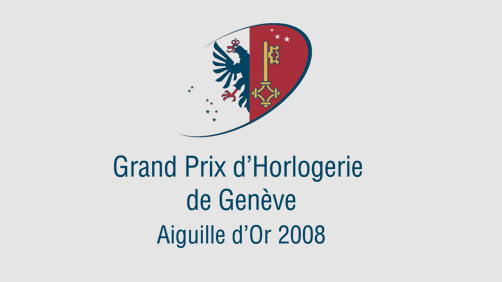
Aiguille d'Or 2008
-
About
THIS MODEL WAS PRODUCED BETWEEN 2010 AND 2017.
AN EXCLUSIVE COLLECTION AVAILABLE ONLY FOR F.P. JOURNE WATCH OWNERS.
WITH A LIMITED PRODUCTION OF ABOUT 900 TIMEPIECES PER YEAR, F.P. JOURNE WANTED TO OFFER AN EVEN MORE EXCLUSIVE TIMEKEEPER THAT WOULD BE AVAILABLE ONLY FOR OWNERS OF AN F.P. JOURNE WATCH. WITH A CASE MADE IN PLATINUM, THE MOST PRECIOUS METAL, F.P. JOURNE HAS CREATED A DISTINGUISHED LACQUERED BLACK DIAL THAT PERSONALIZES EVEN FURTHER THE ELEGANCE OF THE BRAND WATCHES. THE BLACK LABEL COLLECTION WAS BORN.
THE BLACK LABEL COLLECTION IS AVAILABLE ONLY IN THE F.P. JOURNE BOUTIQUES AND ESPACES.
FRANÇOIS-PAUL JOURNE, INGENIOUS RESEARCHER INTO USEFUL AND ORIGINAL TIMEPIECES, ONCE AGAIN SURPRISED US WITH AN UNPRECEDENTED CHRONOGRAPH. THE ART OF CONVERTING 6KM/H INTO 36'000KM/H.
THE HAND-WOUND MECHANICAL MOVEMENT OF THE CENTIGRAPHE INDICATES ELAPSED TIMES FROM A 100TH OF A SECOND TO 10 MINUTES, VISIBLE ON 3 DIALS, EACH WITH A TIME SCALE IN RED AND A TACHOMETER SCALE IN BLACK.
THE TACHOMETER SCALES CONVERTS TIME UNITS FOR 1 KILOMETRE INTO SPEEDS RANGING FROM 6 KM/H —WALKING PACE — TO 36,000 KM/H, WELL ABOVE THE ESCAPE VELOCITY OF A ROCKET GOING INTO LOW-LEVEL ORBIT.
THE INDICATIONS
THE 100TH OF A SECOND HAND REVOLVES AROUND THE DIAL IN ONE SECOND ON A SCALE MARKED IN HUNDREDTHS OF A SECOND. THEORETICALLY IT IS POSSIBLE TO TIME AN OBJECT MOVING AT 36,000 KM/H WITH THE TACHOMETER ON THE WATCH FACE, ON WHICH 36’000 IS FACING THE 10 ON THE 100TH OF A SECOND SCALE.
ON THE DIAL AT 2 O’CLOCK, THE HAND REVOLVES ONCE EVERY 20 SECONDS ON A TIME SCALE DIVIDED INTO SECONDS. THE EXTERNAL TACHOMETER SCALE INDICATES SPEEDS.
THE THIRD DIAL, AT 6 O’CLOCK, GRADUATED FOR 10 MINUTES, HAS A SIMILAR TACHOMETER SCALE WITH SPEEDS CORRESPONDING TO 20-SECOND MARKERS. THUS, FOR EXAMPLE, A KILOMETRE TRAVELLED IN THREE MINUTES 40 SECONDS REPRESENTS A SPEED OF 16.4KM/H (TO WITHIN A DECIMAL).
PATENTED ERGONOMIC CHRONOGRAPH
THE CHRONOGRAPH IS STARTED, STOPPED AND ZEROED BY A ROCKER AT 2 O’CLOCK IN THE CASE BAND, INSTEAD OF THE USUAL BUTTONS ON EITHER SIDE OF THE CROWN. THIS ERGONOMIC DESIGN, PERFECTLY FITTED TO THE WRISTWATCH, IS PATENTED.
PATENTED CHRONOGRAPH MECHANISM
A SECOND PATENT WAS GRANTED FOR THE MECHANISM’S INGENIOUS CONFIGURATION, WHICH EFFECTIVELY ISOLATES THE CHRONOGRAPH FROM THE TIMEKEEPING FUNCTION. THIS MEANS THE BALANCE AMPLITUDE IS UNAFFECTED WHEN THE CHRONOGRAPH IS RUNNING.
THE HANDS OF THE 100TH OF A SECOND, THE 20 SECONDS, AND THE 10 MINUTES COUNTERS ARE DRIVEN BY TWO DIFFERENT WHEEL TRAINS, THEMSELVES DRIVEN BY THE CENTRE OF THE MAINSPRING (SYSTEM PATENTED FOR THE SONNERIE SOUVERAINE). THE 1-SECOND COUNTER AND THE 20-SECONDS COUNTER ARE DRIVEN BY TWO WHEEL-TRAINS ON EITHER SIDE OF A SINGLE INTERMEDIATE WHEEL DRIVEN BY THE BARREL ARBOR (PATENTED FOR THE SONNERIE SOUVERAINE).
ANOTHER SEPARATE TRAIN OF WHEELS, ALSO DRIVEN BY THE BARREL ARBOR, DRIVES THE 10-MINUTES HAND.
1/100TH SECOND RECORDER HAND
THE 100TH OF A SECOND HAND, RELEASED BY THE WATCH'S ESCAPEMENT, MAKES ONE REVOLUTION OF THE DIAL PER SECOND. A WHEEL MOUNTED ON THE ESCAPE WHEEL (4TH WHEEL OF THE GOING TRAIN) RELEASES THE ARBOR TO WHICH THE HAND IS FITTED. THE SECONDS ARE DRIVEN BY THE GOING TRAIN FROM THE BARREL, AND BY THE ENERGY OF THE CHRONOGRAPH TRAIN, AS TRANSMITTED BY THE BARREL ARBOR.
ONE INGENIOUS FEATURE OF THE 100TH OF A SECOND IS THAT IT MAY BE STOPPED ANYWHERE ALONG ITS ONE-SECOND JOURNEY AROUND ITS DIAL, EVEN BETWEEN TWO 100TH-SECOND DIVISIONS, ENABLING A FRACTIONAL READING.
THIS IS ACHIEVED BY VERTICALLY DISENGAGING THE PINION OF THE 100TH OF A SECOND HAND FROM THAT OF THE ESCAPEMENT, WHICH PRESSES ON THE PIVOT SHANK AND ACTS AS A BRAKE.
RETURN TO ZERO
THE 20-SECONDS HAND AND THE 10-MINUTES HAND ARBORS ARE ZEROED BY HAMMER LEVERS ACTING ON SNAIL CAMS. THE 100TH OF A SECOND HAND IS STOPPED AT ZERO BY A BEAK PROTRUDING FROM ITS PINION, WHICH PRESSES ON A LEVER AND THUS BLOCKS THE CHRONOGRAPH TRAIN.
MAINTAINING POWER AND POWER RESERVE
THE BARREL FEATURES A MAINTAINING POWER SYSTEM IN ORDER TO ENSURE THAT THE DRIVING FORCE DOES NOT DECREASE DURING WINDING.
THE MAINSPRING SUPPLIES AT LEAST A 80 HOURS OF POWER RESERVE WITHOUT THE CHRONOGRAPH, AND 24 HOURS WITH THE CHRONOGRAPH RUNNING.
THE CENTIGRAPHE, AN ATYPICAL GODFATHER: JEAN TODT
FOR THE CREATION OF THE CENTIGRAPHE, THINGS HAPPENED SLIGHTLY DIFFERENTLY THAN FOR OTHER CREATIONS. I MET JEAN TODT THROUGH THE ICM FOUNDATION, AND DURING THE COURSE OF OUR MEETINGS WE DISCUSSED THE IDEAL CHRONOGRAPH FOR THE WORLD OF CAR RACING.
RESEARCH I CARRIED OUT OVER 15 YEARS AGO FOR THE CREATION OF AN EXPONENTIAL CHRONOGRAPH QUICKLY SHOWED ME THAT A CHRONOGRAPH WITH 3 HANDS REVOLVING AT DIFFERENT SPEEDS WAS A GOOD STARTING POINT. I FOLLOWED UP WITH RESEARCH ON CHRONOGRAPH PUSHERS, ON QUESTIONS REGARDING THE BALANCE OF POWER IN THE MOVEMENT, REQUIREMENTS, AND ENERGY LOSS, AND I MADE USE OF A PATENT REGISTERED FOR THE SONNERIE SOUVERAINE. I PATENTED TWO ADDITIONAL INNOVATIONS CONCERNING MOTRICITY. I AM PROUD THAT JEAN TODT HAS AGREED TO BE THE CENTIGRAPHE’S GODFATHER.
THE CENTIGRAPHE CONTRIBUTES TO THE MEDICAL RESEARCH OF THE ICM
IN PURCHASING THE CENTIGRAPHE, YOU ARE ALSO SUPPORTING THE MEDICAL RESEARCH CARRIED OUT BY THE ICM – INSTITUTE OF BRAIN AND SPINAL CORD IN PARIS - TO HELP FIGHT DISEASES SUCH AS ALZHEIMER’S, PARKINSON’S, AND MULTIPLE SCLEROSIS...
ALONG WITH PROFESSOR GÉRARD SAILLANT, LUC BESSON, JEAN RÉNO, JEAN TODT, MICHELLE YEOH AND MICHAEL SCHUMACHER, AMONGST OTHERS, FRANÇOIS-PAUL JOURNE HAS COMMITTED TO DONATING 30% OF THE PROFITS FROM THE SALE OF EACH CENTIGRAPHE TO THE ICM, WITH NO TIME LIMIT.
WWW.ICM-INSTITUTE.ORG -
Testimony
CENTIGRAPHE SOUVERAIN
36,000 KM/H AT YOUR FINGERTIPS
THE ART TO CONVERT 6KM/H IN 36.000KM/H
A SPECTACULAR WATCH, THE CENTIGRAPHE SOUVERAIN,
IS A MECHANICAL CHRONOGRAPH UNLIKE ANY OTHER
FOR THE CREATION OF THE CENTIGRAPHE, THINGS HAPPENED SLIGHTLY DIFFERENTLY THAN FOR OTHER CREATIONS. I MET JEAN TODT THROUGH THE ICM FOUNDATION, AND DURING THE COURSE OF OUR MEETINGS WE DISCUSSED THE IDEAL CHRONOGRAPH FOR THE WORLD OF CAR RACING. I THUS REMEMBER RESEARCH I CARRIED OUT OVER 15 YEARS AGO FOR THE CREATION OF AN EXPONENTIAL CHRONOGRAPH QUICKLY SHOWED ME THAT A CHRONOGRAPH WITH 3 HANDS REVOLVING AT DIFFERENT SPEEDS WAS A GOOD STARTING BASE. I FOLLOWED UP WITH RESEARCH ON CHRONOGRAPH PUSHERS, ON QUESTIONS OF THE BALANCE OF POWER IN THE MOVEMENT, REQUIREMENTS, AND ENERGY LOSS, AND I MADE USE OF A PATENT REGISTERED FOR THE SONNERIE SOUVERAINE. I PATENTED 2 ADDITIONAL INNOVATIONS CONCERNING MOTRICITY. I AM PROUD THAT JEAN TODT HAS AGREED TO BE THE CENTIGRAPHE’S GODFATHER.
THE CENTIGRAPHE REPRESENTS A TECHNICAL ACHIEVEMENT IN BEING THE FIRST WRISTWATCH IN THE WORLD EQUIPPED WITH A SINGLE HAND WOUND MOVEMENT ALLOWING TO MEASURE ELAPSED TIMES FROM ONE HUNDREDTH OF A SECOND TO 10 MINUTES ON THREE SUBSIDIARY DIALS. THE HAND OF THE FIRST DIAL AT 10 O’CLOCK MAKES A TURN IN ONE SECOND ON A SCALE MARKED IN HUNDREDTHS OF A SECOND, MAKING IT THEORETICALLY POSSIBLE TO TIME AN OBJECT MOVING AT 360,000 KM/H, OR APPROXIMATELY 1/3000THS OF THE SPEED OF LIGHT. THE HAND OF THE SECOND DIAL AT 2 O’CLOCK IS MAKING A TOUR IN 20 SECONDS, AND THE THIRD HAND OF THE DIAL AT 6 O’CLOCK, MAKES A TOUR IN 10 MINUTES. A TECHNICAL PROWESS TO WHICH CAN BE ADDED A POWER RESERVE OF 80 HOURS – AND 24 HOURS WITH THE CHRONOGRAPH RUNNING.
THE CENTIGRAPHE CONTRIBUTES TO THE MEDICAL RESEARCH OF THE ICM
IN PURCHASING THE CENTIGRAPHE, YOU ARE ALSO SUPPORTING THE MEDICAL RESEARCH CARRIED OUT BY THE ICM – INSTITUTE OF BRAIN AND SPINAL CORD IN PARIS - TO HELP FIGHT BRAIN AND SPINAL CORD DISEASES SUCH AS ALZHEIMER’S, PARKINSON’S, AND MULTIPLE SCLEROSIS… ALONG WITH PROFESSOR GÉRARD SAILLANT, LUC BESSON, JEAN RÉNO, JEAN TODT, MICHELLE YEOH AND MICHAEL SCHUMACHER, AMONGST OTHERS, I HAVE COMMITTED TO DONATING 30% OF THE PROFITS FROM THE SALE OF EACH CENTIGRAPHE TO THE ICM, WITH NO TIME LIMIT.
(WWW.ICM-INSTITUTE.ORG)
FRANÇOIS-PAUL JOURNE -
Technical description
Technical Specifications
Movement :- Winding : Manual
- Movement in 18K rose gold : 50 jewels
Dimensions :- Overall diameter : 34.40 mm
- Casing-up diameter : 34.00 mm
- Overall height : 5.60 mm
- Height of hands : 1.45 mm
- Height of winding system : 2.69 mm
- Diameter of stem thread : S1.20 mm
Balance :Free-sprung balance
Four adjustable inertia weights
Anachron balance spring
Mobile stud holders
Pinned GE stud
Spring pinned to the collectFrequency :21,600 v/h, (3Hz)
Inertia :10.10 mg / cm2
Angle of lift :52°
Amplitude :0h dial up: 320°
24h dial up: 280°Escapement :In-line lever escapement
15-tooth escape wheelIndications :Central hours and minutes
One-second chronograph hand at 10 o'clock.
20-seconds chronograph hand at 2 o'clock.
10-minutes chronograph hand at 6 o'clock.Chronograph :Separate chronograph train driven by directly from the mainspring.
1/100th second readoutAutonomy :80 ± 2 hours with the chronograph stopped
24 ± 2 hours with the chronograph runningFinishes :Circular stripes on the bridges
Circular graining on the baseplate
Polished screw heads with chamfered slots
Pegs with polished rounded ends
Straight-grained steel workControl :Rocker arm to start, stop and zero the chronograph
Three-position winding crown:
Position 0: disengaged
Position 1: winding
Position 2: time-settingNumber of Parts :Movement without dial: 284
Cased up with strap: 324Movement :- Winding : Manual
- Movement in 18K rose gold : 50 jewels
Dimensions :- Overall diameter : 34.40 mm
- Casing-up diameter : 34.00 mm
- Overall height : 5.60 mm
- Height of hands : 1.45 mm
- Height of winding system : 2.69 mm
- Diameter of stem thread : S1.20 mm
Balance :Free-sprung balance
Four adjustable inertia weights
Anachron balance spring
Mobile stud holders
Pinned GE stud
Spring pinned to the collectFrequency :21,600 v/h, (3Hz)
Inertia :10.10 mg / cm2
Angle of lift :52°
Amplitude :0h dial up: 320°
24h dial up: 280°Escapement :In-line lever escapement
15-tooth escape wheelIndications :Central hours and minutes
One-second chronograph hand at 10 o'clock.
20-seconds chronograph hand at 2 o'clock.
10-minutes chronograph hand at 6 o'clock.Chronograph :Separate chronograph train driven by directly from the mainspring.
1/100th second readoutAutonomy :80 ± 2 hours with the chronograph stopped
24 ± 2 hours with the chronograph runningFinishes :Circular stripes on the bridges
Circular graining on the baseplate
Polished screw heads with chamfered slots
Pegs with polished rounded ends
Straight-grained steel workControl :Rocker arm to start, stop and zero the chronograph
Three-position winding crown:
Position 0: disengaged
Position 1: winding
Position 2: time-settingNumber of Parts :Movement without dial: 284
Cased up with strap: 324
At the heart of the movementAt the heart of the movementBrevet - Chronographe N°: EP 07405107 | Switch (rocker arm) N°: EP 1818734 A1Technical description
For this movement unlike any other, F.P. Journe has set up an ergonomic chronograph activation system with a rocker arm that allows the chronograph to start, stop and zero at 2 o’clock in the case band, instead of the usual buttons on either side of the crown. The chronograph function has also been isolated from the timekeeping function, meaning that the balance amplitude is unaffected when the chronograph is running.
These two innovations have been patented.
The hand-wound mechanical movement of the Centigraphe indicates elapsed times from a 100th of a second to 10 minutes, visible on 3 dials, each with a time scale in red and a tachometer scale in black.
The tachometer scales converts time units for 1 kilometer into speeds ranging from 6 km/h —walking pace — to 36'000 km/h, well above the escape velocity of a rocket going into low-level orbit.Brevet - Chronographe N°: EP 07405107 | Switch (rocker arm) N°: EP 1818734 A1
Technical description
For this movement unlike any other, F.P. Journe has set up an ergonomic chronograph activation system with a rocker arm that allows the chronograph to start, stop and zero at 2 o’clock in the case band, instead of the usual buttons on either side of the crown. The chronograph function has also been isolated from the timekeeping function, meaning that the balance amplitude is unaffected when the chronograph is running.
These two innovations have been patented.
The hand-wound mechanical movement of the Centigraphe indicates elapsed times from a 100th of a second to 10 minutes, visible on 3 dials, each with a time scale in red and a tachometer scale in black.
The tachometer scales converts time units for 1 kilometer into speeds ranging from 6 km/h —walking pace — to 36'000 km/h, well above the escape velocity of a rocket going into low-level orbit.
Technical Specifications
- Winding : Manual
- Movement in 18K rose gold : 50 jewels
- Overall diameter : 34.40 mm
- Casing-up diameter : 34.00 mm
- Overall height : 5.60 mm
- Height of hands : 1.45 mm
- Height of winding system : 2.69 mm
- Diameter of stem thread : S1.20 mm
Free-sprung balance
Four adjustable inertia weights
Anachron balance spring
Mobile stud holders
Pinned GE stud
Spring pinned to the collect
21,600 v/h, (3Hz)
10.10 mg / cm2
52°
0h dial up: 320°
24h dial up: 280°
In-line lever escapement
15-tooth escape wheel
Central hours and minutes
One-second chronograph hand at 10 o'clock.
20-seconds chronograph hand at 2 o'clock.
10-minutes chronograph hand at 6 o'clock.
Separate chronograph train driven by directly from the mainspring.
1/100th second readout
80 ± 2 hours with the chronograph stopped
24 ± 2 hours with the chronograph running
Circular stripes on the bridges
Circular graining on the baseplate
Polished screw heads with chamfered slots
Pegs with polished rounded ends
Straight-grained steel work
Rocker arm to start, stop and zero the chronograph
Three-position winding crown:
Position 0: disengaged
Position 1: winding
Position 2: time-setting
Movement without dial: 284
Cased up with strap: 324
- Winding : Manual
- Movement in 18K rose gold : 50 jewels
- Overall diameter : 34.40 mm
- Casing-up diameter : 34.00 mm
- Overall height : 5.60 mm
- Height of hands : 1.45 mm
- Height of winding system : 2.69 mm
- Diameter of stem thread : S1.20 mm
Free-sprung balance
Four adjustable inertia weights
Anachron balance spring
Mobile stud holders
Pinned GE stud
Spring pinned to the collect
21,600 v/h, (3Hz)
10.10 mg / cm2
52°
0h dial up: 320°
24h dial up: 280°
In-line lever escapement
15-tooth escape wheel
Central hours and minutes
One-second chronograph hand at 10 o'clock.
20-seconds chronograph hand at 2 o'clock.
10-minutes chronograph hand at 6 o'clock.
Separate chronograph train driven by directly from the mainspring.
1/100th second readout
80 ± 2 hours with the chronograph stopped
24 ± 2 hours with the chronograph running
Circular stripes on the bridges
Circular graining on the baseplate
Polished screw heads with chamfered slots
Pegs with polished rounded ends
Straight-grained steel work
Rocker arm to start, stop and zero the chronograph
Three-position winding crown:
Position 0: disengaged
Position 1: winding
Position 2: time-setting
Movement without dial: 284
Cased up with strap: 324

Technical description
For this movement unlike any other, F.P. Journe has set up an ergonomic chronograph activation system with a rocker arm that allows the chronograph to start, stop and zero at 2 o’clock in the case band, instead of the usual buttons on either side of the crown. The chronograph function has also been isolated from the timekeeping function, meaning that the balance amplitude is unaffected when the chronograph is running.
These two innovations have been patented.
The hand-wound mechanical movement of the Centigraphe indicates elapsed times from a 100th of a second to 10 minutes, visible on 3 dials, each with a time scale in red and a tachometer scale in black.
The tachometer scales converts time units for 1 kilometer into speeds ranging from 6 km/h —walking pace — to 36'000 km/h, well above the escape velocity of a rocket going into low-level orbit.

Technical description
For this movement unlike any other, F.P. Journe has set up an ergonomic chronograph activation system with a rocker arm that allows the chronograph to start, stop and zero at 2 o’clock in the case band, instead of the usual buttons on either side of the crown. The chronograph function has also been isolated from the timekeeping function, meaning that the balance amplitude is unaffected when the chronograph is running.
These two innovations have been patented.
The hand-wound mechanical movement of the Centigraphe indicates elapsed times from a 100th of a second to 10 minutes, visible on 3 dials, each with a time scale in red and a tachometer scale in black.
The tachometer scales converts time units for 1 kilometer into speeds ranging from 6 km/h —walking pace — to 36'000 km/h, well above the escape velocity of a rocket going into low-level orbit.
